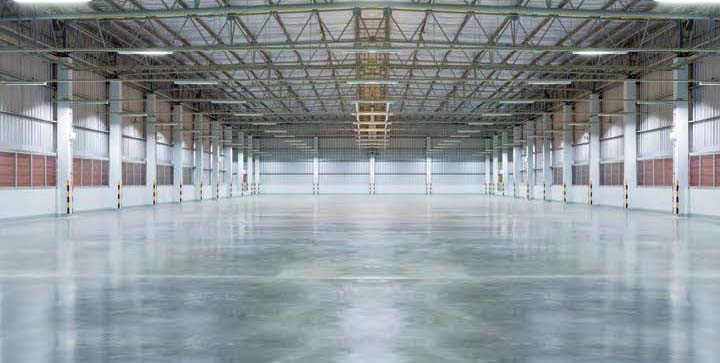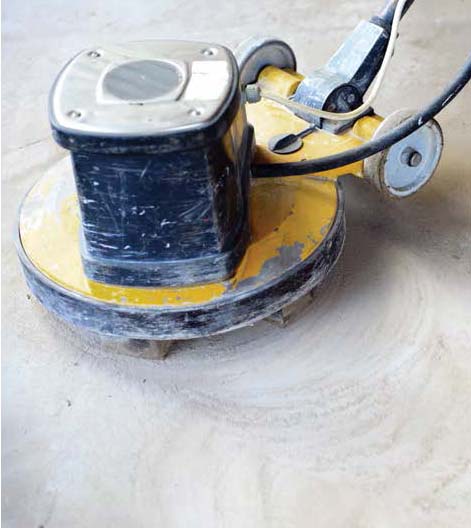
6 Commercial Spaces That Benefit from Polished Concrete Surfaces

By: Todd Gillman
The flooring in commercial spaces faces a unique set of challenges not met by private residences. For example, it must be able to stand up to increased foot traffic, more accidents, and frequent vehicle traffic–all while providing an attractive appearance that meshes with the interior ambiance. To this effect, polished concrete is one of the most advantageous products on the market today. The following breakdown looks at how various commercial spaces can benefit from polished concrete surfaces.
1) HIGH SCHOOLS AND UNIVERSITIES
There is arguably no commercial space that will see heavier foot traffic than a high school or college building when class is dismissed. The hallways become a veritable sea of hundreds of students stampeding to make it to their next class on time, spilling drinks and snacks along the way without the time or tools to clean them up. As a result, flooring in these spaces needs to be extremely durable and stain resistant, fending off damage until the custodial staff can arrive.
In addition to the durability and ease of maintenance that a polished concrete floor provides, it has some other benefits that are especially appealing to academic institutions, including:
- Versatility in finish, with the concrete capable of being stained to create a warmer, more inviting aspect than many other commercial hard flooring options
- Great for ADA compliance, as wheelchairs and motorized carts can easily move across a polished concrete surface to accommodate students with disabilities
- Non-toxic and does not harbor allergens, helping ensure interior air quality and protecting the health of building inhabitants
2) INDUSTRIAL STYLE OFFICES
The industrial-style office is exploding in popularity as commercial office design continues to migrate away from the cookie cutter office cubicle in favor of spaces that have more character and unique features. Some of the key hallmarks of the industrial office include:
- Large, metal tables and workstations High ceilings with prominent wood or metal rafters
- Exposed pipes in the office bathrooms Rustic wood shelving and metal storage baskets in place of traditional desk drawers, filing cabinets, or bookshelves
When all of these points are considered, it is clear how concrete flooring can seamlessly mesh with this rugged style of interior design.
3) RESTAURANTS & BREWERIES
In addition to the obvious benefits of being able to withstand the foot traffic and food and beverage spills that dining establishments deal with in high frequency, there are a couple of other benefits that make polished concrete a strong choice for restaurants and breweries:
Polished concrete is very difficult to chip or scratch. As seating arrangements are constantly being rearranged inside of dining establishments, with chairs and tables being dragged and pushed to meet the needs
of the next party, it is critical to choose a flooring that not only lends itself to this frequent rearrangement but will not show signs of damage from maneuvering furniture
Many contemporary restaurants and breweries are being designed with large windows and garage-style doors so that the exterior patio can be easily connected with interior seating to create natural, fresh-air spaces. Therefore, it is crucial that the flooring can not only transition well between the interior and exterior but also be resistant to UV damage
4) STORAGE UNITS
Statistics reveal that more than 1 out of every 10 Americans rent off-site storage for their sea of possessions, representing the fastest-growing segment in the commercial real estate industry over the past four decades. And as the cost of housing continues to increase at a record clip in 2021, people are being forced to relocate and downsize their dwellings, causing huge interest in tiny homes and van-style living and the need for more off-site storage space for furniture and electronics that will not fit in their residence.
Therefore, storage units can no longer be oversized boxes to cram unwanted inheritances and tacky knick-knacks. Consumers want modern storage units to feature the most fire-resistant building construction types, come equipped with climate controls and insulation, and have flooring that will not degrade over time or buckle under heavy pressure, causing damage to expensive possessions, making polished concrete one of the best materials for contemporary storage units.
5) RETAIL SPACES
Building managers for retail spaces must be able to efficiently change the face of a location when one patron moves out and a new business moves in. Polished concrete will stand up admirably as motorized carts and forklifts come to move out inventory from a departing business and set up for a new one, providing a versatile, attractive appearance that requires little maintenance during this transition.
6) HOSPITALS
Hospitals are another type of commercial building in which ADA accessibility should be a primary focus, as a larger-than-normal percentage of visitors will be entering via wheelchair and motorized cart. In addition, medical personnel must be able to easily wheel beds and carts from one location to another, making the even durable surface of polished concrete ideal for this purpose.
In addition, as many hospital patrons will have difficulty evacuating the building in the event of a fire, the elite fire resistance of concrete should make it a primary choice in medical facilities.
CHOOSE POLISHED CONCRETE FOR YOUR COMMERCIAL BUILDING TODAY
Polished concrete offers a number of unique benefits to commercial spaces, such as elite durability, unmatched fire resistance, and a versatile appearance that goes well with a number of projects. From high school hallways to hospitals, industrial offices to restaurants, polished concrete is the ideal choice for a wide array of commercial properties.
Todd Gillman is the content director for the Innovative Building Materials blog and a content writer for the building materials industry. He is focused on helping fellow homeowners, contractors, and architects discover materials and methods of construction that save money, improve energy efficiency, and increase property value.












